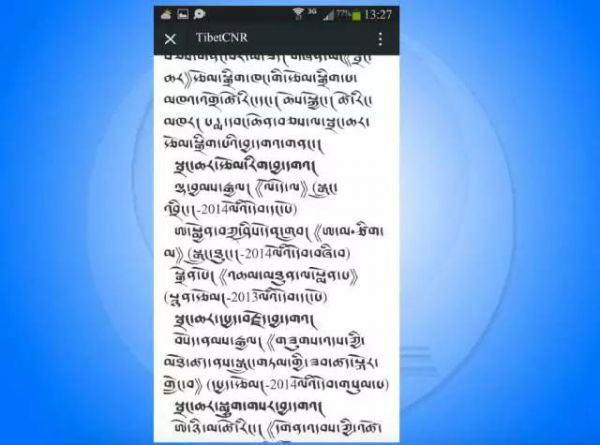New fonts give Tibetans texting options
Updated: 2016-01-14 08:11
(Xinhua and China Daily)
|
||||||||
 |
|
The Qomolangma Tibetan font displayed in an android system. CHINA DAILY |
Apart from being artistic, the Qomolangma fonts also had to display a strong historical flavor while meeting the different needs of publishing houses.
The most eye-catching fonts are the Qomolangma-Dunhuang, which is based on Tibetan works collected in the Dunhuang Grottoes in Gansu province, the oldest Tibetan works on murals; the Qomolangma-Woodblock, which is based on the scriptures in the Drepung Monastery in Lhasa; the Qomolangma-Edict, which is based on ancient imperial edicts and historical documents; and the Qomolangma-Horyig, which is based on historical stamps and documents.
To Tashi Tsering's surprise, the Horyig font previously reserved for the seals of imperial families and prestigious living Buddhas was particularly welcomed by users. It allows a publishing house to test a vertical layout for the first time and gives Tibetans a chance to have their own seals. "Horyig fonts are not easy to recognize and are barely used now. Growing interest might revive the use of the dying font," he said.
When Tashi Tsering was studying at Tsinghua University in 1985, IBM had just began manufacturing personal computers.
"When I first saw Chinese characters pop up on the screen, I started to dream big. I wished one day Tibetan could also be typed and I thought I could be the one to stand up and give it a try," he said.
In the following years, he has studied computer technology at Tsinghua and Tibetan at Minzu University of China. After joining the research center upon graduation, he devoted himself fully to the development of information technology in the Tibetan language.
Over the past 30 years, he has participated in the development of Chinese and international computer coding standards for Tibetan, invented the Himalaya Tibetan font for Microsoft and compiled the Tibetan-Chinese-English Information Technology Dictionary.
Based on international encoding standards and OpenType technology, the New Qomolangma fonts adapt to the operation systems of Windows, Macintosh, Android and Linux, and are highly compatible with different computers and smartphones.
As previous fonts were developed according to self-defined coding standards, they would appear as gibberish on other operating systems, making Tibetan database construction very inefficient.
Lu, of the Tibetology Institute, said more and more technicians realized the only way Tibetans could embrace information technology was to follow internationally recognized standards.
"The spread of the Qomolangma fonts will definitely speed up the process," he said.

 Monkey portraits by Chinese ink painting masters
Monkey portraits by Chinese ink painting masters
 SWAT members hold romantic wedding in E China
SWAT members hold romantic wedding in E China
 Stephane Peterhansel regains Dakar Rally lead
Stephane Peterhansel regains Dakar Rally lead
 Goodbye to steam trains
Goodbye to steam trains
 Top 11 events in the wearable sector in 2015
Top 11 events in the wearable sector in 2015
 Execs introduce new models at Detroit Auto Show
Execs introduce new models at Detroit Auto Show
 Foreigners learn mushroom cultivation skills in Xi'an
Foreigners learn mushroom cultivation skills in Xi'an
 Academy releases top 6 archaeological finds of 2015
Academy releases top 6 archaeological finds of 2015
Most Viewed
Editor's Picks

|

|

|

|

|

|
Today's Top News
Obama to deliver final State of the Union speech
Shooting rampage at US social services agency leaves 14 dead
Chinese bargain hunters are changing the retail game
Chinese president arrives in Turkey for G20 summit
Islamic State claims responsibility for Paris attacks
Obama, Netanyahu at White House seek to mend US-Israel ties
China, not Canada, is top US trade partner
Tu first Chinese to win Nobel Prize in Medicine
US Weekly

|

|







